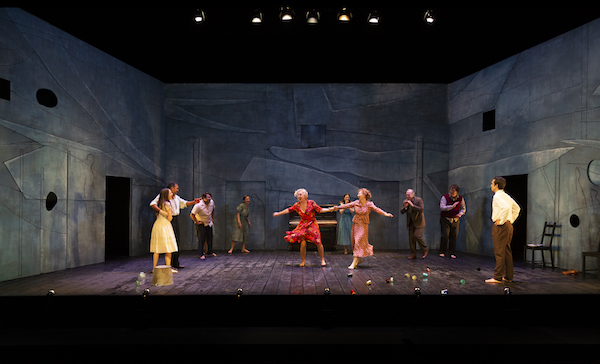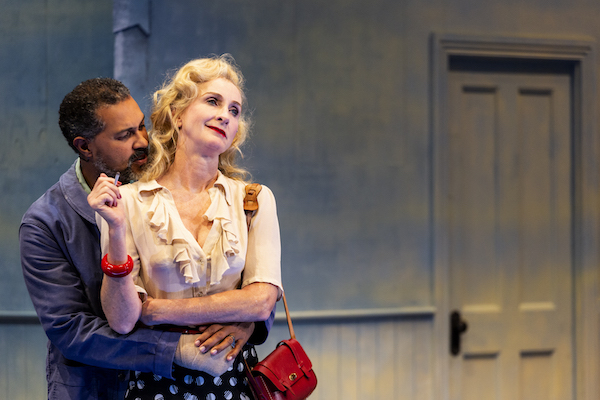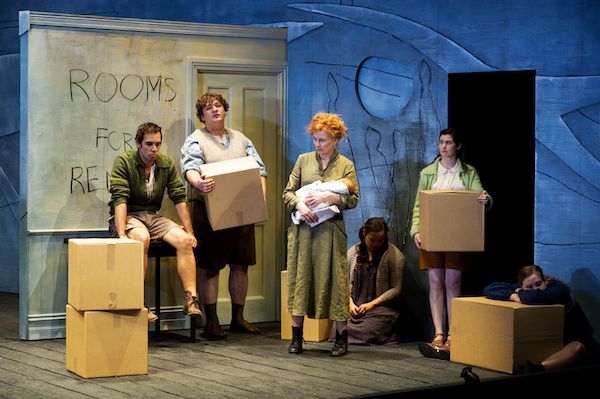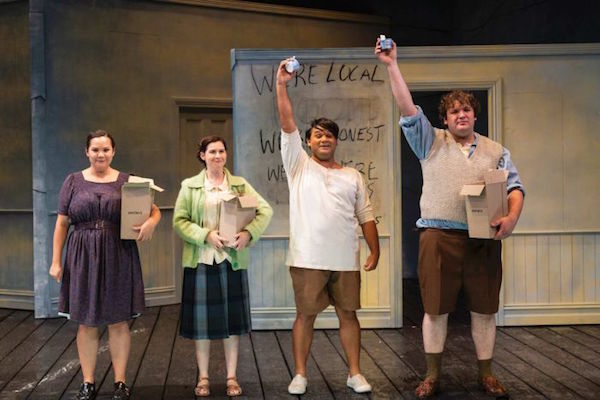Robert Reid considers the epic nostalgia that is the phenomenon of Malthouse Theatre’s Cloudstreet
Cloudstreet is legendarily long. Five hours long, in fact, including two intervals, during the first of which dinner is served (we’ll return to the dinner). Adapted from the Tim Winton novel by Nick Enright and Justin Monjo in 1998 and staged at Malthouse (then Playbox) in 1999, it’s become a kind of landmark in Australian theatre history – and because of how Australia deals with its history, we really don’t have many of them.
Neil Armfield’s production is often spoken of with awed nostalgia. I haven’t read the book and I only managed to get a little way into the television adaptation, so I’ll be dealing with the production as I experienced it on Saturday night. Matthew Lutton’s Cloudstreet, not Tim Winton’s nor Neil Armfield’s.
The first thing that really needs to be said is that the text hasn’t aged well. Which is frustrating, because I so wanted to enjoy this one. The play tells the story of two families, the Pickles and the Lambs, Australian battlers who end up sharing a ramshackle house in Perth. We see them grow over 20 years, from the accidental almost-drowning of the favourite of the Lamb children, Fish (Benjamin Oakes), which results in a form of brain damage that changes the boy forever, through to the marriage of his brother Quick (Guy Simon) to the daughter of the Pickles family, Rose (Brenna Harding).
Over five hours there is a lot of story. As in a soap opera, each character has their trials and triumphs: some marry, some fall pregnant, some die. Beginning with the parents of the two families first and then moving through the years as their children grow, the focus of the story shifts from one generation to the next.
The Sturt Street precinct has a ‘90s revival going on at the moment, with Cloudstreet and Cosí playing simultaneously a block away from each other. There’s been talk lately by some, me included, about the importance of returning to canonical Australian plays, and it’s good to see these plays have been exhumed; but as I say in my essay, the point of returning to these works is to re-examine them in the light of today. I’m not convinced that’s happened with Cloudstreet.

Heteronormative harmony. Photo: Pia Johnson
I must stress that it’s by no means a bad night in the theatre. I’m glad I got the chance to see it: it’s a cultural artefact and I was too young and too poor to see it in its first incarnation. There are many enjoyable performances at the centre of this production. The relationship between Bert LeBonté’s Sam Pickles and Greg Stone’s Lester Lamb is joyously sweet throughout (which is refreshing in a culture that still demands blokes be mates, but not too expressive). Alyson White’s Oriel is a crumbling tower of steely strength and Brenna Harding’s Rose is the battered, unrelenting conscience of the play. These performances carry me through the evening.
But I found many things problematic, beginning with the play itself.
It’s clear that this text hasn’t matured along with its audience. There’s plenty of nostalgia, both for the historical periods it recreates and its own production history. Audience members around us came out saying how much they had loved the 1990s production and how this new staging just seemed to fly by. My experience wasn’t really one of flight, but thankfully it also didn’t drag – which is admirable for a five hour production. Instead, it maintains a steady pace that never quite gripped me, but also never totally let me go.
Cloudstreet is a kind of squatter’s epic, a station drama in the tradition of 1950s plays like Dulcie Dunlop Ladds’ We Have Our Dreams or Anthony Coburn’s The Bastard Country. John McCallum describes station dramas in his magisterial book Belonging as plays that “explore the painful transition from pioneering days to a new life based in a hard-won tradition of family and settlement. In the sets of these plays, the old bush shack has become the living room and veranda of an established homestead…”
It’s not an exact parallel, but there’s an undeniable inheritance from these plays. In this instance, two poor families, the Pickles and the Lambs, are bedevilled by disasters, depressions and world war, and struggle on as the world changes around them. And it’s full of very familiar tropes.
This leads me to the first of my nagging doubts about this text: the whiteness of the narrative. Though the Malthouse production makes a concerted effort to bring some diversity to the casting, the text itself still tells a story of white triumph against the adversity of the land. As the families struggle – with gambling, with loss, with each other – in the background are the spirits that haunt the inhabitants of Number One Cloud Street. There are the spirits of Stolen Generations children once housed in this old building and also the wise spirits of the land, watching over and looking out for the white families. These spirits are inevitably played by the Indigenous actors. It’s a cliché that sits awkwardly in a contemporary staging; using Indigenous voices to frame the white stories while also pushing them into the background.
The dark history of Cloud Street is that the house was once a mission for stolen Aboriginal girls which resulted in the death of one and subsequently also their tormentor, a cruel white governess (more dead women) which turns the whole building into a Haunted House on an Ancient Burial Ground Trope.
In conversation with Richard Watts, Lutton says: “The idea of one Indigenous voice has been expanded to having multiple voices. Some of the text has been rearranged in its order, which gives a different focus and elevates parts of that Indigenous history and voice in a different way, and there’s been Noongar language integrated into the play as well. In many ways it’s about allowing the Indigenous history and voice in it to be more present, less siloed, and more active in the storytelling, as opposed to something that is a framing device or a commentary,’
It’s a laudable effort, one that more mainstream theatres in this country would do well to attempt, and I applaud the casting of Guy Simon as Quick, as well as Ebony McGuire and Ian Michael as some of the younger Pickle children. But I can’t say I’m convinced that this solves the problem. “Multiple voices” translates as three, and the Noongar language that has been integrated into the play for the most part leans heavily on a single repeated phrase. Also, by giving the Story Teller roles to the Indigenous performers, shared between Michael and McGuire, as well as casting Michael as Quick’s vision of the running man, this Cloudstreet (I think inadvertently) recreates a kind of Ethnic Magician/Spirit trope.
Similarly, the women of the play are not treated super well. My wife Sayra pointed out on the way home that there are a lot of dead and abused women, well outnumbering the men. It begins with the death of Wagga, the girl at school who Quick Lamb has fixated on, who is hit by a train without speaking more than a few words (if any). Her death really only functions as a plot point in Quick’s story – a classic “woman in the fridge” trope – and the women of the play are generally so under-served that Fish literally can’t even see his own mother.
Speaking of Fish, it’s also admirable that Malthouse made the effort to cast an actor with a lived experience of disability in this key role. In the same interview with Watts, Lutton says, “I didn’t want in any way to be having Fish portrayed in a way where disability was performed on stage. It’s an extraordinary role, and I also wanted it to be an opportunity for a performer with lived experience of disability to be telling the story of Fish on the main stage.”
Oakes is a fine actor who has worked with Back to Back, and there’s obviously no reason he couldn’t perform a person with any disability. And that’s exactly what he does: he performs Fish’s disability. While there is research to say that paediatric traumatic brain injury and Autism spectrum disorder share similar qualities, I’m not convinced that autism is close enough to brain damage to make this not a “performance”. It’s also a problem that the brain-damaged Fish is the one who can hear ghosts and see the future: it feels uncomfortable close to the madman as holy fool trope. As with a lot of the gestures towards inclusivity with the Cloudstreet experience, it’s close but no cigar.

Bert Labonte and Natasha Herbert as the Pickles. Photo: Pia Johnson
I want to stress here, again, that Malthouse has been a champion of diversity on the Australian stage with their programming, perhaps achieving it best when they simply provide space for Indigenous, CALD and LGBTIQ+ artists. With Cloudstreet, it feels as if the company recognises the need for diversity in the text, but the choices and interventions made to achieve it seem superficial. Perhaps the story itself structurally resists any amelioration.
The resolution to the conflicts in both these families is, for example, a heteronormative marriage and the production of a baby. As the final moments of the play draw to a close, the new baby brings the drunken and abusive Dolly (Natasha Herbert) and her estranged daughter Rose together: it sobers Dolly up, cures Oriel’s depression, sways Sam to not sell the house and convinces Rose to take Fish on her honeymoon with Quick. She also reverse her decision to make a new life away from the families who have been the bane of her life, and moves back into Cloudstreet.
The baby even releases the spirits of the dead child and governess that have haunted the building for the whole story. Why? I’m prepared to accept, grudgingly, that a marriage and new baby might bring a temporary or forced bonhomie to the two families: but what does it have to do with the ghosts?
I could continue to poke woke holes in this production, but I had other reservations. There are not only political issues with a text that hasn’t been updated all that well: they segue into loose ends and dramaturgical issues.
Fish’s death in the final moment of the play comes out of nowhere (aside from some prophetic foreshadowing from the wise and mystical Indigenous spirits) and concludes the evening with a giant raw wound of an open question. After all these years of handwringing over Fish’s “dud miracle”, to kill him off and cut to black is as irritating as The Sopranos cutting to black in the middle of a ….
Other questions: there’s a disappearing baby in the Lamb family, present in act one but never seen again. There is Lester’s infidelity with Dolly, which happens and is then never mentioned again – is this a secret the two of them will keep from Oriel until they die? I’m perfectly comfortable with unresolved plot developments and character elements, and I don’t demand a neat resolution for everything in Cloudstreet; but these feel like major shifts in the lives of these characters that remain unaddressed. And they hang unsatisfyingly over the ending.

The disappearing baby of act one. Photo: Pia Johnson
I didn’t love either the cameo of the writer as Rose’s flash city boyfriend. His use of her as secretary, fuck buddy and country-girl muse feels hackneyed. It’s a writery gimmick that smacks more of ego than a nod to self-referentiality: rather than being a clever device that feints towards a kind of pseudo-reality for the story (I, the writer, once dated a girl on whom Rose and her family are based) it feels predatory. Especially in a party scene where the writer tells his flash literary friends that he wants to write a story about Rose’s family and the funny old house they live in. It pulls me out of the world of the play just long enough to think, “oh, I see what you did there… good for you.”
And what about the bizarre addition of the killer in the final act? Without this, the night might as easily have ended after the marriage of Quick and Rose. It would be as dramatically satisfying as the actual ending. It’s hard to see how we’d get through the final hour of the evening without the killer to pull us through. This is what I mean about loose-end dramaturgy. Rather than introducing a serial killer whose presence in the city disturbs Quick – now turned policeman – and using (one might say overusing) the killer to silently menace the women of the play, a more satisfying arc might have been to address the unresolved issues that hang over the play: the Dolly, Ori and Lester triangle, for example. Honestly, this was the only reason I could see for going back in after the wedding: if anything had the potential to upend this unearned family cohesion, it was the revelation of Lester’s infidelity.
I wonder if the story is really served by being five hours and four acts long. Do the 20 years that pass between the Pickles and the Lambs really benefit from this duration, or does it sacrifice a concise dramaturgy for a rambling faux-epic aesthetic that leads to a messy and incomplete experience of their world? I’m not sure.
Finally: why is it marketed as the “Cloudstreet Experience”?
On our way out (after the opening night standing ovation and four curtain calls) I overheard a few audience members around me saying “from the description I was expecting it to be more immersive (or maybe involved) than that.” I was, too. With the exception of the dinner and the ice cream, there’s little more here than a really, really long play.
When we arrive in the foyer we see a fridge of Streets Ice cream (vanilla Dixie cups, all white: bad sign?) We’re welcome to help ourselves, and a few people do. There’s also a full page ad for Dixie cups in the program. Well, okay, yay sponsorship, it’s good that corporations are supporting live theatre…
Oh, no, wait, once we’re well into act one and the Lambs have opened their general store, the kids begin chanting from the wings: “Ice cream. Ice cream. Ice cream”. My heart sinks. Up go the house lights and the cast emerges with a truckload of Dixie cups, offering them to the audience. “Who wants some?” Yes, everyone’s thrilled, hands go up. “Me, me!” Except, for obvious reasons, the cast can only reach the front few rows and the sides of a few rows further back.

Ice cream! Photo: Pia Johnson
I’m not sure how vanilla ice cream goes with a lingering aftertaste of house red (and I can’t have lactose without pills anyway) so I wasn’t too jealous… I did wonder, though, if such brutally blunt product placement is a dangerous precedent. By slamming Lamb’s Famous Vanilla Ice Cream together with the obviously branded Dixie cups, that moment also casually destroys the suspension of disbelief the production has spent an hour and a half building, for no real reason other than a gimmicky “give the audience sweets” schtick.
The dinner is provided at the first interval: 40 minutes of lining up for and quickly ramming into our faces a choice of eggplant or lamb shoulder. Sadly, there are no pickles on offer to go with the lamb, though maybe it’s good that dinner wasn’t so totally literal. Even so, dinner feels like a missed trick. It’s perfectly tasty (we had the eggplant), but if this is the “Cloudstreet Experience”, dinner is an ideal opportunity to carry on the world building of the play. The Bagging Room upstairs and the foyer downstairs could surely have had some design touches to suggest 1940s Perth; maybe the food itself could have reflected the Australia the play attempts to recreate.
I suppose it does recreate the dinner served mid-play in 1999. That dinner became part of the legend of Cloudstreet: a play so long dinner had to be provided! It’s nice enough, but…it’s just food. We all file out, collect our tv trays and hover in 2019, talking about our memories of the first production or what we plan to do tomorrow. The lack of design in this moment reflects my dissatisfaction with the design of the show overall.
The set design, with grey walls that hector in the action on all sides, remind me of a freeway cut-through or the outside of a ‘90s public building, maybe a contemporary art museum in Canberra. Out of these walls come smaller retractable walls that glide in and out of the sculpted concrete, becoming the various rooms in the Pickles/Lamb house. Often these walls don’t extend far enough into the space, so the internal doors of the house don’t make it all the way onto stage. There are also some bewildering costume choices: modern-looking bulky jeans or a dressy croptop jar against the more old-fashioned clothes.
And that awful tent. In act two, Ori retreats from the house into a tent outside, driven to isolate herself as she struggles to maintain her faith and fight a growing depression. So, how hard is it to get an actual tent to set up on stage? Or at least to create something that echoes the weird grey walls on the outside. Surely that would do just as well to catch Ori’s shadow and show us her retreat from the world? Instead the “tent” looked like two stretched and primed white canvasses stacked on top of each other. Was this a rehearsal device that stood in for a real tent that never eventuated? Oh, that tent. I hated that tent.
Just as the design is frustrating, so too is the production’s inconsistent deployment of spectacle. Sudden blackouts are over-used through the first two and a half hours, and under-used in the last. Water bubbles up through the floor in each act and drops from the fly in the final moments. It’s full of striking images that aren’t all that striking. There’s nothing we haven’t seen before, and it’s less spectacular every time we see it.
The “shifty shadow of fortune” falls fleetingly across this production, touching down in contemporary Australia in Lester’s observation that sometimes he can hear the land howling, and that he doesn’t – we don’t, none of us white Australians do – belong here. In that moment, there’s a genuine thrill of resonance with now. I guess in five hours of theatre, any production must surely blunder into at least 30 seconds of contemporary relevance.
Cloudstreet, adapted by Nick Enright and Justin Monjo from the novel by Tim Winton, at The Malthouse. Directed by Matthew Lutton. Set and Costume Design by Zoe Atkinson. Lighting Design by Paul Jackson. Sound Design by David Franzke. Composition by Elizabeth Blake. Performed by Arielle Gray, Brenna Harding, Natasha Herbert, Bert LaBonte, Ebony McGuire, Mikayla Merks, Ian Michael, Benjamin Oakes, Scott Sheridan, Guy Simon, Greg Stone and Alyson Whyte.
Wheelchair access and hearing assistance available.
Auslan Interpreted: Part 1: 7.30pm, Thursday 6 June, Part 2: 7.30pm, Friday 7 June
Audio Described: 5pm, Saturday 25 May
Contains some adult material, coarse language, herbal cigarettes, gunshots and dynamic sound. A full list of triggering content is available at this link.

